The Dynamics Characteristics of Soil Water Infiltration and Capillary Rise for Saline–Sodic Soil Mixed with Sediment
Abstract
1. Introduction
2. Materials and Methods
2.1. Experimental Design
2.2. Simulation Models
2.3. Data Collection and Analysis
3. Results and Discussion
3.1. Variation of Saturated Soil Hydraulic Conductivity and Porosity Ratio
3.2. Characteristics of Upward Water Transportation
3.2.1. Variation of Capillary Water Rise Height
3.2.2. Variation of Capillary Rise Rate
3.2.3. Variation of Soil Water Adsorption
3.2.4. Relationship between Capillary Rise Height and Cumulative Soil Water Adsorption Amount
3.3. Characteristics of Downward Soil Water Transportation
3.3.1. Wetting Front Migration
3.3.2. Soil Water Infiltration Rate
3.4. Comparison of Downward and Upward Soil Water Movement
3.4.1. Duration Time
3.4.2. Soil Water and Salt Distribution
3.5. Modeling of Soil Water Infiltration and Capillary Water Rise
4. Conclusions
Author Contributions
Funding
Data Availability Statement
Acknowledgments
Conflicts of Interest
References
- Cui, B.; Yang, Q.; Yang, Z.; Zhang, K. Evaluating the ecological performance of wetland restoration in the Yellow River delta, China. Ecol. Eng. 2009, 35, 1090–1103. [Google Scholar] [CrossRef]
- Peng, J.; Chen, S.; Dong, P. Temporal variation of sediment load in the yellow river basin, china, and its impacts on the lower reaches and the river delta. Catena 2010, 83, 135–147. [Google Scholar] [CrossRef]
- Ma, T.; Li, X.; Bai, J.; Ding, S.; Zhou, F.; Cui, B. Four decades’ dynamics of coastal blue carbon storage driven by land use/land cover transformation under natural and anthropogenic processes in the yellow river delta, China. Sci. Total Environ. 2019, 655, 741–750. [Google Scholar] [CrossRef] [PubMed]
- Guan, Y.; Liu, G. Remote sensing detection of dynamic variation of the saline land in the yellow river delta. Remote Sens. Nat. Resour. 2003, 15, 19–22. [Google Scholar]
- Xiao, Y.; Zhao, G.; Li, T.; Zhou, X.; Li, J. Soil salinization of cultivated land in Shandong province, China—dynamics during the past 40 years. Land Degrad. Dev. 2019, 30, 426–436. [Google Scholar] [CrossRef]
- Li, X.; Wan, S.; Kang, Y.; Chen, X.; Chu, L. Chinese rose (Rosa chinensis) growth and ion accumulation under irrigation with waters of different salt contents. Agric. Water Manag. 2016, 163, 180–189. [Google Scholar] [CrossRef]
- Yu, S.; Liu, J.; Eneji, A.; Han, L.; Tan, L.; Liu, H. Dynamics of soil water and salinity under subsurface drainage of a coastal area with high groundwater table in spring and rainy season. Irrig. Drain. 2016, 65, 360–370. [Google Scholar] [CrossRef]
- Zhao, Y.; Wang, S.; Li, Y.; Zhuo, Y.; Liu, J. Effects of straw layer and flue gas desulfurization gypsum treatments on soil salinity and sodicity in relation to sunflower yield. Geoderma 2019, 352, 13–21. [Google Scholar] [CrossRef]
- Berezniak, A.; Ben-Gal, A.; Mishael, Y.; Nachshon, U. Manipulation of soil texture to remove salts from a drip-irrigated root zone. Vadose Zone J. 2018, 17, 170019. [Google Scholar] [CrossRef]
- Li, X.Y. Gravel–sand mulch for soil and water conservation in the semiarid loess region of northwest china. Catena 2002, 52, 105–127. [Google Scholar] [CrossRef]
- Sun, J.; Kang, Y.; Wan, S. Effects of an imbedded gravel–sand layer on reclamation of coastal saline soils under drip irrigation and on plant growth. Agric. Water Manag. 2013, 123, 12–19. [Google Scholar] [CrossRef]
- Zhang, Y.; Li, H.; Hong, H.; Wang, X.; Chen, W. Punching and filling sand method increasing water infiltration and desalting rate of saline-alkali soil under flooding irrigation. Trans. CSAE 2017, 433, 76–83. [Google Scholar] [CrossRef]
- Nie, J.; Stevens, T.; Rittner, M.; Stockli, D.; Pan, B. Loess plateau storage of northeastern Tibetan plateau-derived Yellow River sediment. Nat. Commun. 2015, 6, 8511. [Google Scholar] [CrossRef]
- Dai, Q.; Cao, W.H.; Shi, H.L.; Wang, Y.H. Analyses on some problems in irrigation districts and benefits of allocating diverted water and sediment along the lower yellow river. J. China Inst. Water Resour. Hydropower Res. 2007, 5, 15–20. [Google Scholar] [CrossRef]
- Wang, Q.; Shao, M.A.; Wang, Z. Mechanism and simulating model for muddy water infiltration. Trans. CSAE 1999, 15, 135–138. [Google Scholar]
- Yao, X.; Li, J.; Huang, X.; Sun, X. Distribution of yellow river’s silt in field under border irrigation. Trans. CSAE 2016, 32, 147–152. [Google Scholar] [CrossRef]
- Liu, L.; Niu, W.; Wu, Z.; Olusola, O.; Guan, Y. Effect of fertilization and sediment flow hydraulic characteristics on emitter clogging in muddy water drip fertigation system. Irrig. Drain. 2018, 67, 713–723. [Google Scholar] [CrossRef]
- Mao, W.; Kang, S.; Wan, Y.; Sun, Y.; Wang, Y. Yellow river sediment as a soil amendment for amelioration of saline land in the yellow river delta. Land Degrad. Dev. 2016, 27, 1595–1602. [Google Scholar] [CrossRef]
- Alqahtani, M.R.A. Effect of addition of sand and soil amendments to loam and brick grit media on the growth of two turf grass species (Lolium perenne and Festuca rubra). J. Appl. Sci. 2009, 9, 2485–2489. [Google Scholar] [CrossRef][Green Version]
- Li, W.; Li, X.; Li, H.; Yang, Y.; Lei, K.; Yao, X. Effects on micro-ecological characteristics in clayey soil of tobacco area under different sand adding proportions. J. Northwest Agric. For. Univ. Sci. Technol. Nat. Sci. Ed. 2012, 40, 85–96. [Google Scholar] [CrossRef]
- Mathur, O.P.; Mathur, S.K.; Talati, N.R. Effect of addition of sand and gypsum to fine-textured salt-affected soils on the yield of cotton and jower (Sorghum) under Rajasthan Canal Command Area conditions. Plant Soil 1983, 74, 61–65. [Google Scholar] [CrossRef]
- Zhou, L.; Li, R.; Miao, Q.; Dou, X.; Tian, F.; Yu, D.; Sun, C. Effects of different sand ratios on infiltration and water-salt movement of heavy saline-alkali soil in Hetao irrigation area. Trans. CSAE 2020, 36, 116–123. [Google Scholar] [CrossRef]
- Kostiakov, A. On the dynamics of the coefficient of water percolation in soils and on the necessity of studying it from a dynamic point of view for purposes of amelioration. Trans. 6th Comm. Int. Soc. Soil Sci. Russ. 1932, 1, 17–21. [Google Scholar]
- Horton, R.E. The role of infiltration in the hydrologic cycle. Trans. Am. Geophys. Union 1933, 14, 446–460. [Google Scholar] [CrossRef]
- Horton, R.E. Analysis of runoff-plat experiments with varying infiltration-capacity. Trans. Am. Geophys. Union 1939, 20, 693–711. [Google Scholar] [CrossRef]
- Philip, J. The theory of infiltration: 4. Sorptivity and algebraic infiltration equations. Soil Sci. 1957, 84, 257–264. [Google Scholar] [CrossRef]
- Philip, J. The theory of infiltration: 7. Soil Sci. 1958, 85, 333–337. [Google Scholar] [CrossRef]
- Al-Dosary, N.; Al-Sulaiman, M.A.; Aboukarima, A.M. Modelling the unsaturated hydraulic conductivity of a sandy loam soil using Gaussian process regression. Water SA 2019, 45, 121. [Google Scholar] [CrossRef]
- Zolfaghari, A.A.; Mirz, E.S.; Gorji, M. Comparison of Different Models for Estimating Cumulative Infiltration. Int. J. Soil Sci. 2012, 7, 108–115. [Google Scholar] [CrossRef]
- Wang, P.; Jiang, E.; Zhang, Q. Study on the Benefits of Sediment Recycling Model in Yellow River Irrigation District. Yellow River 2010, 32, 143–144. [Google Scholar] [CrossRef]
- Nimmo, J.R. Porosity and Pore Size Distribution. In Encyclopedia of Soils in the Environment; Hillel, D., Ed.; Elsevier: Amsterdam, The Netherlands, 2004; Volume 3, pp. 295–303. [Google Scholar] [CrossRef]
- Rabot, E.; Wiesmeier, M.; Schlüter, S.; Vogel, H.J. Soil structure as an indicator of soil functions: A review. Geoderma 2018, 314, 122–137. [Google Scholar] [CrossRef]
- He, F.; Pan, Y.; Tan, L. Zhang, Z. Li, P. Liu, J. Study of the water transportation characteristics of marsh saline soil in the yellow river delta. Sci. Total Environ. 2017, 574, 716–723. [Google Scholar] [CrossRef] [PubMed]
- Li, P.; Pan, Y.H.; He, F.H.; Tan, L.L.; Ji, S.X. Research on capillary water adsorption characteristics of yellow river delta wetland soil. Chin. J. Agrometeorol. 2017, 38, 378–387. [Google Scholar] [CrossRef]
- Song, R.; Chu, G.; Ye, J.; Bai, L.; Zhang, R.; Yang, J. Effects of surface soil mixed with sand on water infiltration and evaporation in laboratory. Trans. CSAE 2010, 26, 109–114. [Google Scholar]
- Gan, Y.; Liu, H.; Jia, Y.; Zhao, S.; Wei, J.; Xie, H. Infiltration-runoff model for layered soils considering air resistance and unsteady rainfall. Hydrol. Res. 2019, 50, 431–458. [Google Scholar] [CrossRef]
- White, I.; Sully, M. Macroscopic and microscopic capillary length and time scales from field infiltration. Water Resour. Res. 1987, 23, 1514–1522. [Google Scholar] [CrossRef]
- Li, Y.N. Study on the effect of muddy irrigation on soil air pressure. Agric. Res. Arid. Areas 2003, 21, 91–93. [Google Scholar]
- Rodgers, M.; Mulqueen, J.; Healy, M. Surface clogging in an intermittent stratified sand filter. Soil Sci. Soc. Am. J. 2004, 68, 1827. [Google Scholar] [CrossRef]
- Hu, H.; Mao, X.; Barry, D.; Liu, C.; Li, P. Modeling reactive transport of reclaimed water through large soil columns with different low-permeability layers. Hydrogeol. J. 2015, 23, 351–364. [Google Scholar] [CrossRef]
- Liu, B.; Wang, S.; Kong, X.; Liu, X. Soil matric potential and salt transport in response to different irrigated lands and soil heterogeneity in the North China Plain. J. Soils Sediments 2019, 19, 3982–3993. [Google Scholar] [CrossRef]
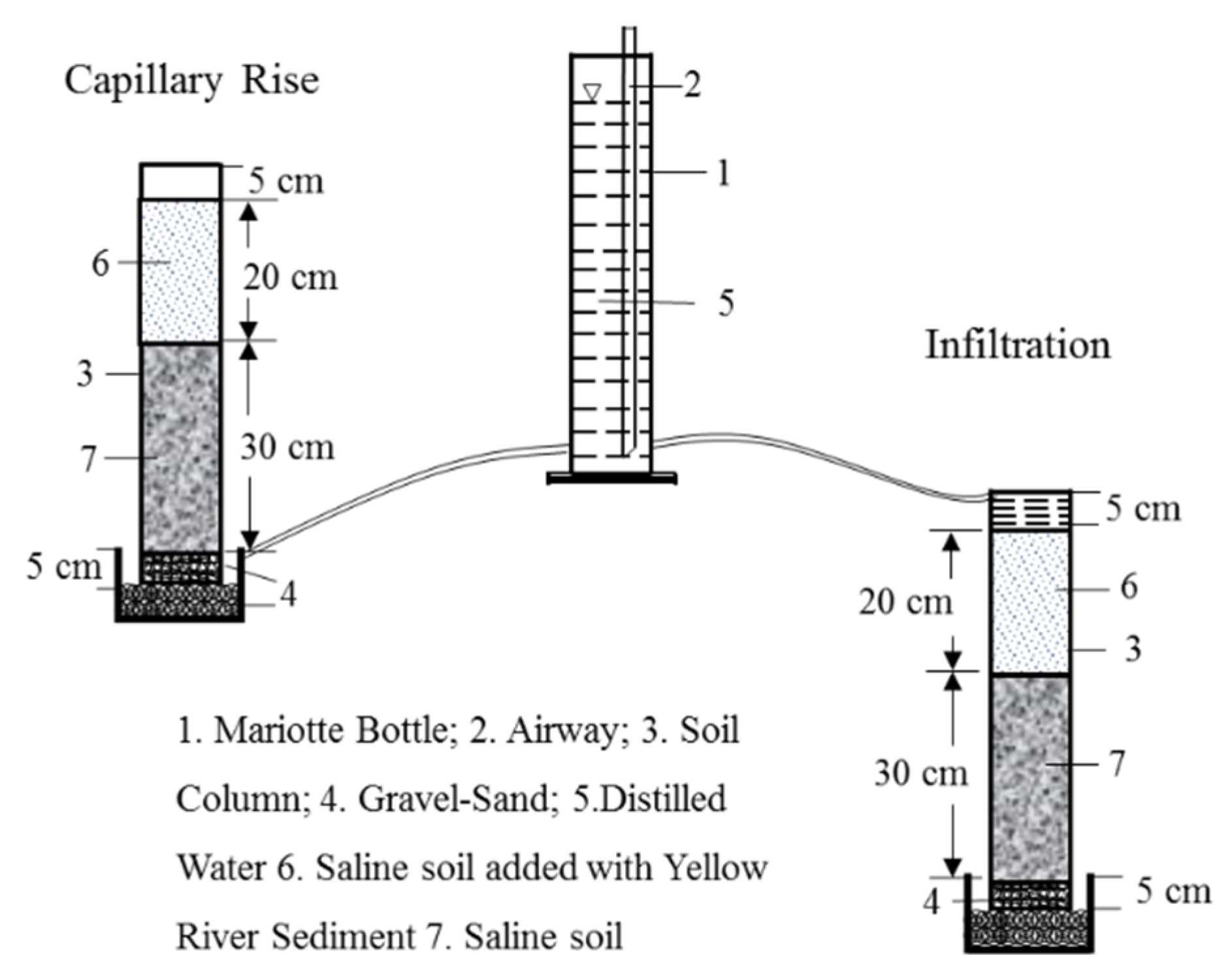
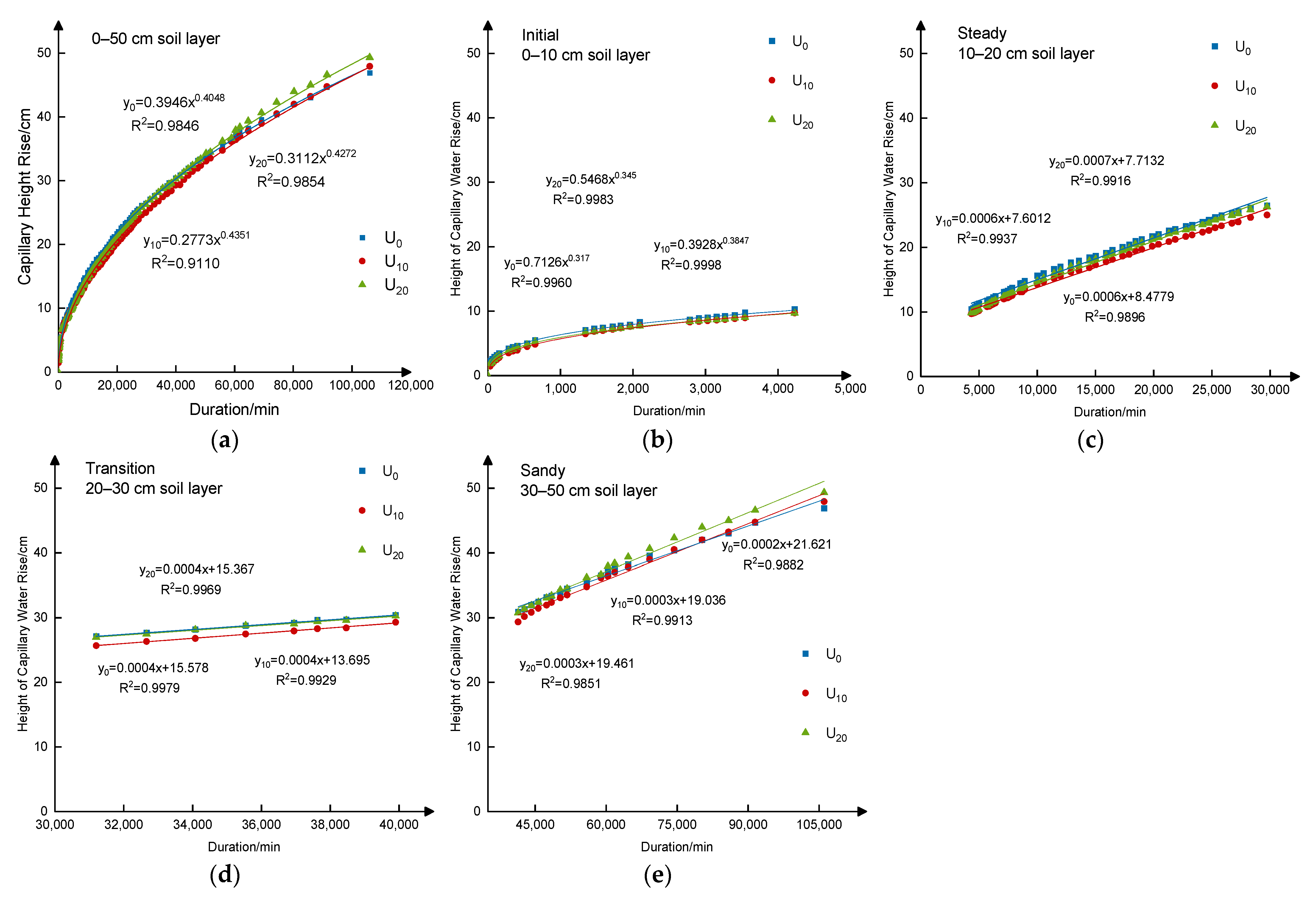
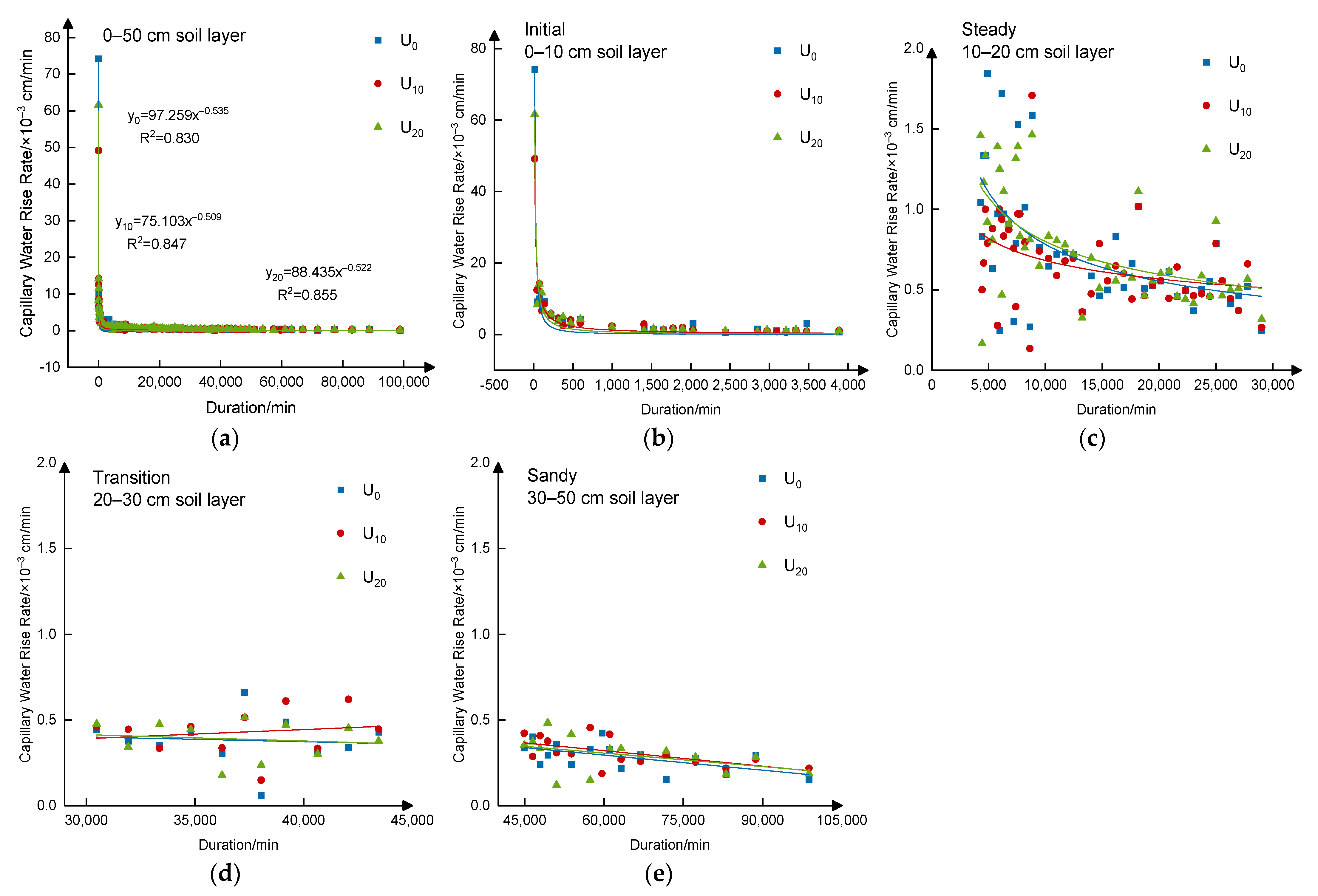
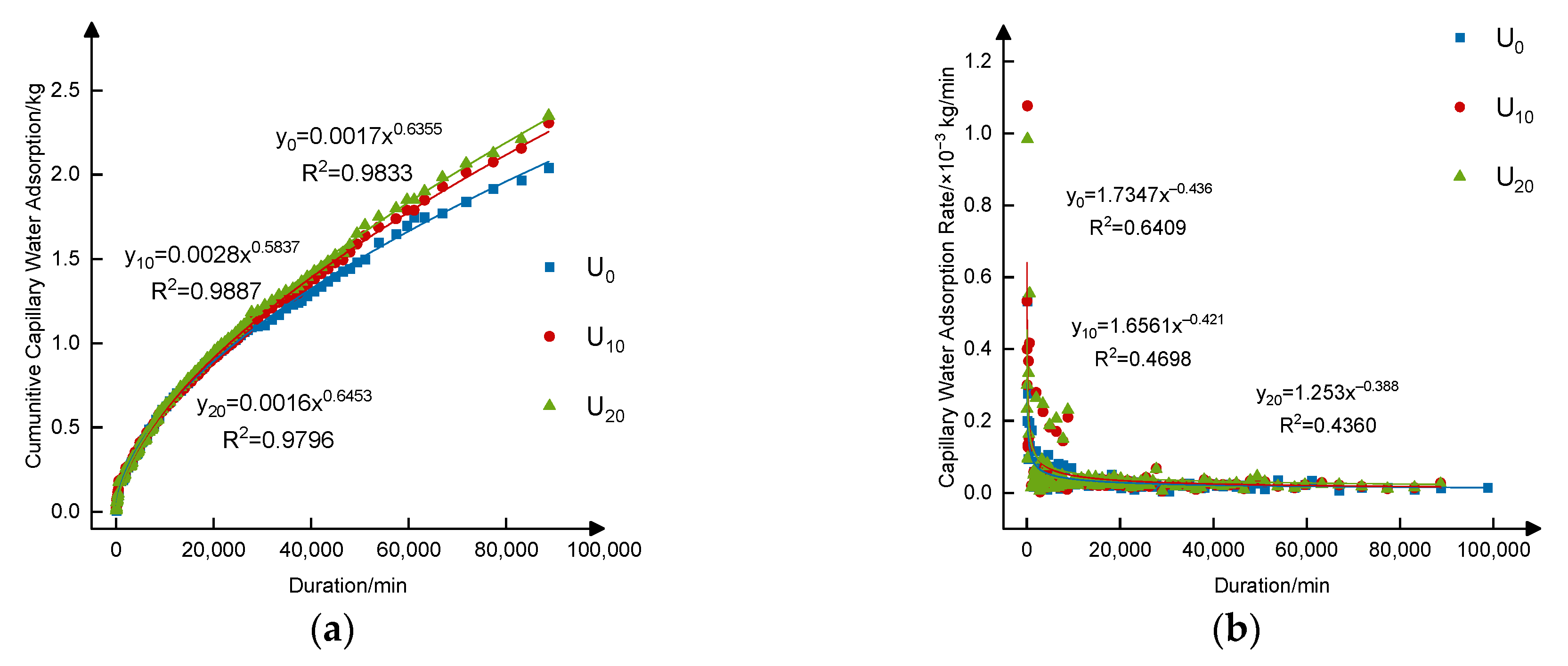
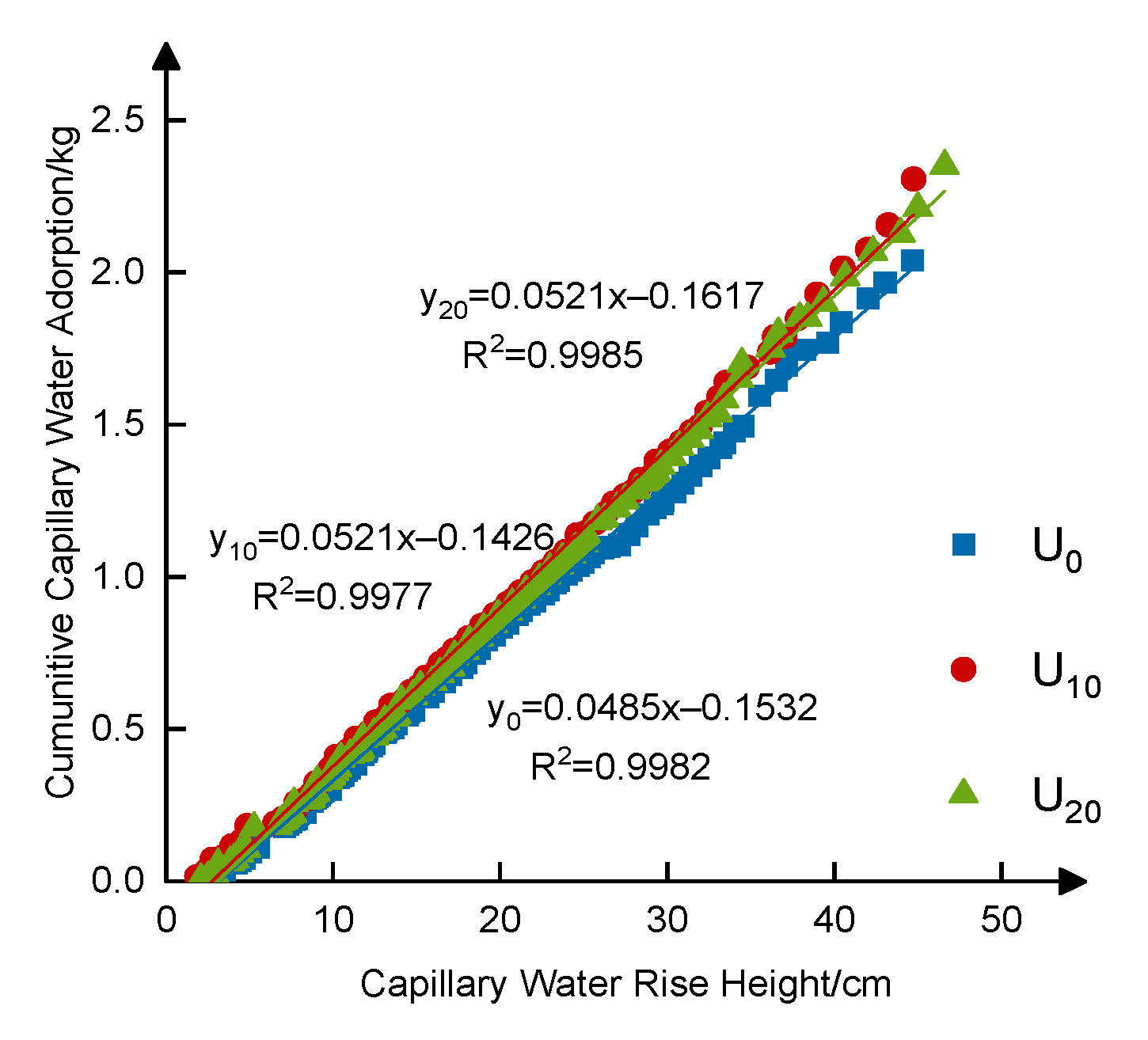
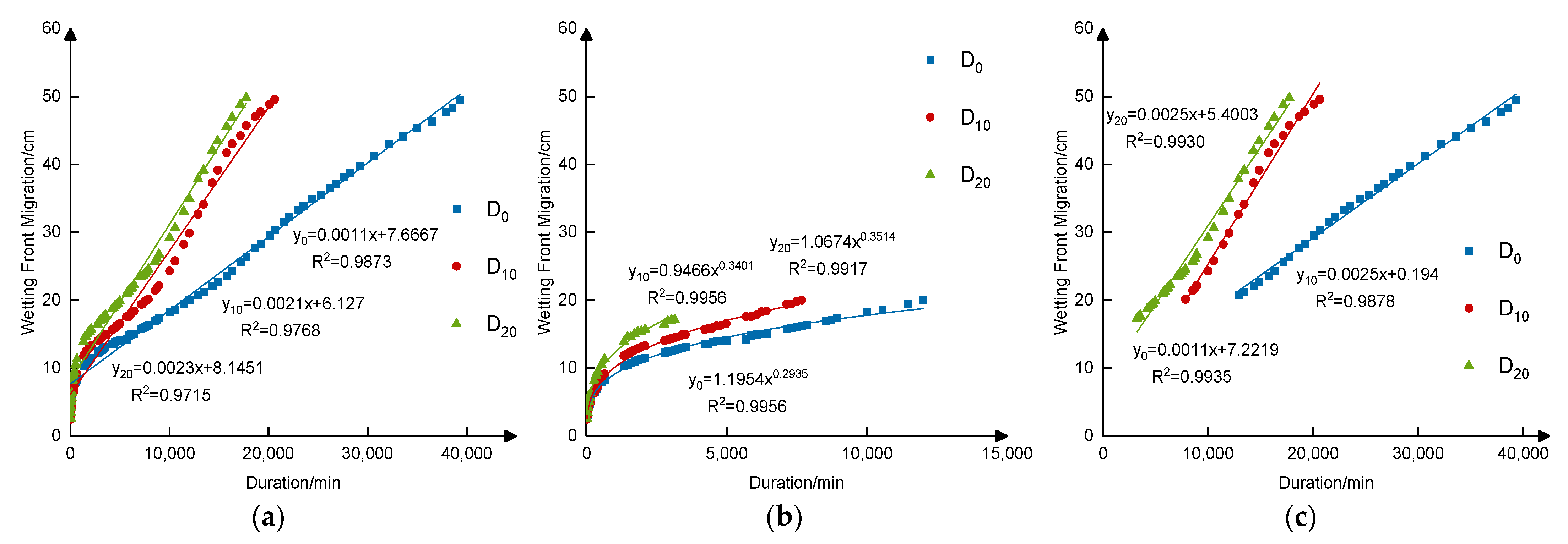
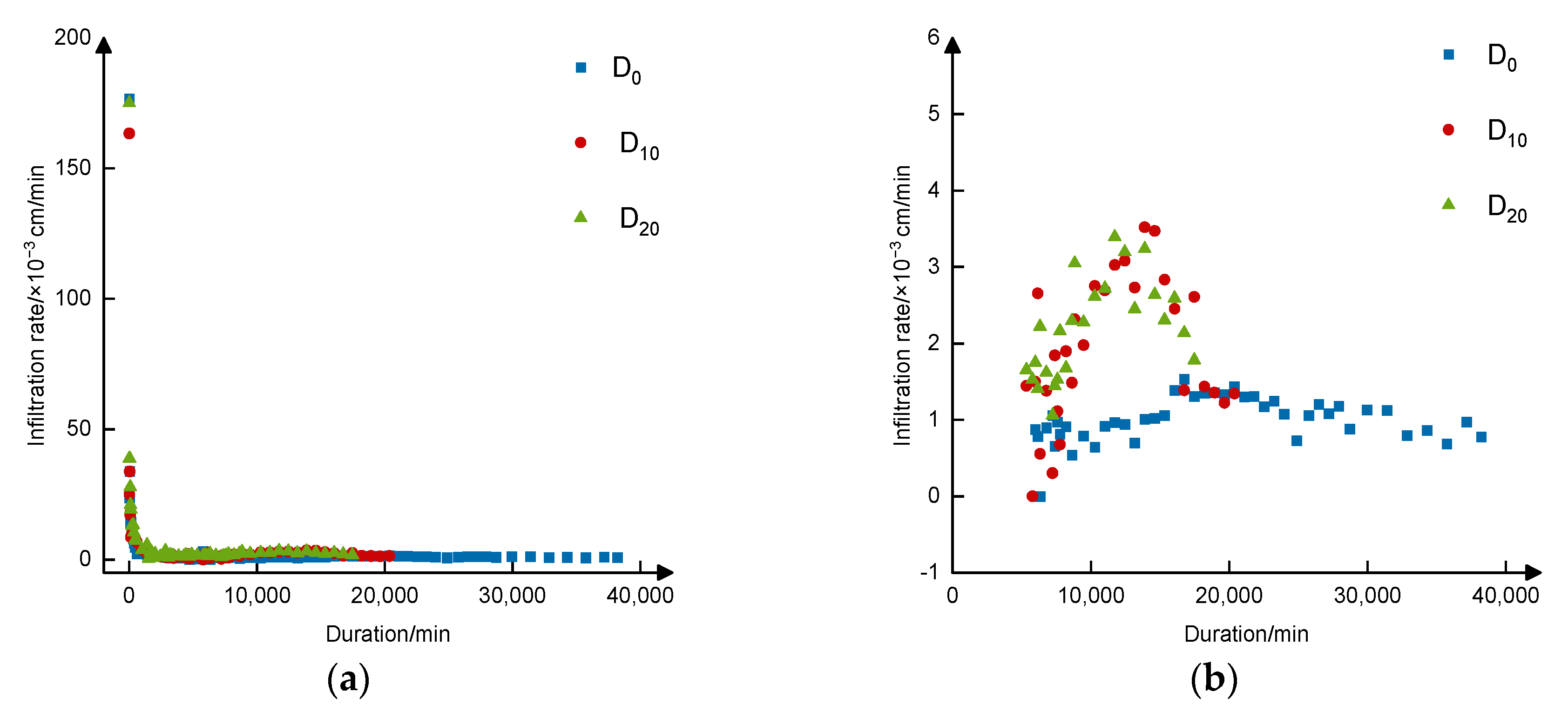
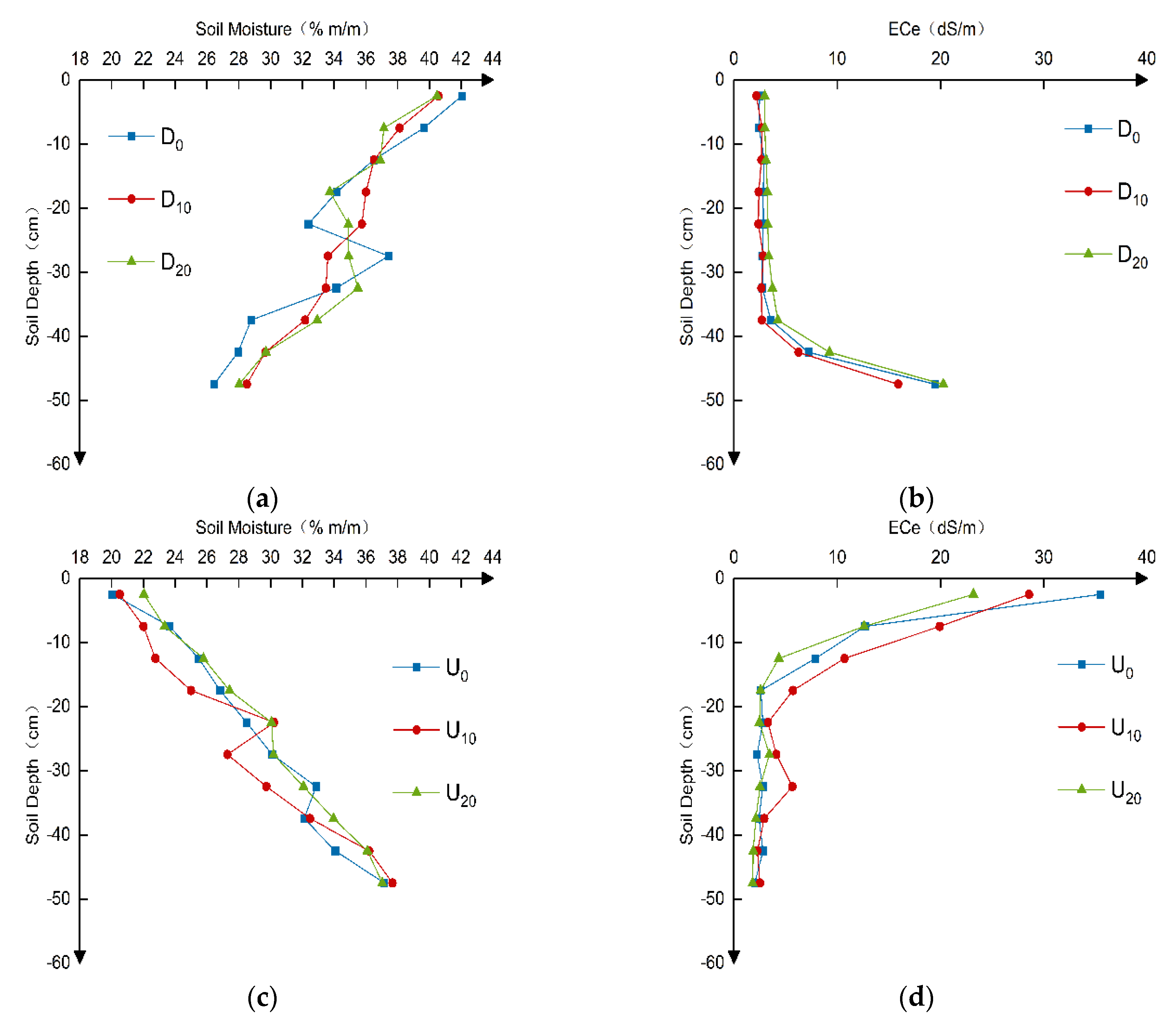
| Treatments | Soil Texture | Percentage of Particle Content (%) | pH | ECe (dS/m) | Organic Matter (g/kg) | Total N (g/kg) | ESP (%) | ||
|---|---|---|---|---|---|---|---|---|---|
| Clay 0–2 μm | Silt 2–50 μm | Sand 50–2000 μm | |||||||
| Sediment | Loamy Fine Sand | 0.39 | 22.91 | 76.69 | 7.6 | 1.78 | 12.42 | 1.42 | 28.7 |
| U0/D0 | Sandy Clay | 35.13 | 19.25 | 45.62 | 8.2 | 6.52 | 3.28 | 0.47 | 10.2 |
| U10/D10 | Sandy Clay | 35.49 | 18.34 | 46.17 | 8.2 | 6.47 | 3.35 | 0.51 | 10.1 |
| U20/D20 | Sandy Clay | 36.07 | 16.64 | 47.29 | 8.1 | 6.50 | 3.61 | 0.56 | 9.7 |
| Sediment Addition (kg/m2) | Treatments | Saturated Soil Hydraulic Conductivity (×103 cm/min) | Ratio of Soil Porosity (%) | ||
|---|---|---|---|---|---|
| Macroporosity | Mesoporosity | Microporosity | |||
| 0 | U0/D0 | 0.36 c | 9.52 c | 13.75 a | 8.67 a |
| 10 | U10/D10 | 1.18 b | 11.41 b | 12.18 ab | 6.51 b |
| 20 | U20/D20 | 4.34 a | 15.56 a | 11.37 b | 3.44 c |
| Treatments | Cumulative Capillary Adsorption Amount (kg) | Capillary Rise Rate (×10−3 cm/min) | Capillary Adsorption Rate (×10−3 kg/min) | |||||||||
|---|---|---|---|---|---|---|---|---|---|---|---|---|
| Initial 0–10 cm | Steady 10–20 cm | Transition 20–30 cm | Sandy 30–50 cm | Initial 0–10 cm | Steady 10–20 cm | Transition 20–30 cm | Sandy 30–50 cm | Initial 0–10 cm | Steady 10–20 cm | Transition 20–30 cm | Sandy 30–50 cm | |
| U0 | 0.342 c | 0.707 c | 0.231 c | 0.761 c | 6.11 a | 0.780 a | 0.397 a | 0.294 c | 0.13 c | 0.036 b | 0.017 b | 0.018 a |
| U10 | 0.373 a | 0.770 a | 0.27 b | 0.894 b | 4.90 c | 0.657 b | 0.412 a | 0.335 a | 0.19 a | 0.042 ab | 0.020 a | 0.022 a |
| U20 | 0.355 b | 0.754 b | 0.285 a | 0.956 a | 5.49 b | 0.781 a | 0.412 a | 0.318 b | 0.17 b | 0.047 a | 0.019 ab | 0.022 a |
| Treatments | Kostiakov | R2 | Philip | R2 | Horton | R2 |
|---|---|---|---|---|---|---|
| U0 | y = 97.259×x−0.535 | 0.8302 | y = 194.77×x−0.5 − 1.6794 | 0.7477 | y = 17.23×EXP(−0.001×x) + 0.2491 | 0.3184 |
| U10 | y = 75.103×x−0.509 | 0.8478 | y = 146.95×x−0.5 − 1.0253 | 0.8713 | y = 16.106× EXP (−0.001×x) + 0.2586 | 0.3837 |
| U20 | y = 88.435×x−0.522 | 0.8551 | y = 171.57×x−0.5 − 1.3432 | 0.8013 | y = 14.444× EXP (−0.001×x) + 0.2755 | 0.4576 |
| D0 | y = 87.723×x−0.479 | 0.706 | y = 360.38×x−0.5 − 4.7121 | 0.8017 | y = 116.96× EXP (−0.0015×x) + 0.6528 | 0.6868 |
| D10 | y = 164.21×x−0.598 | 0.609 | y = 344.85×x−0.5 − 4.7347 | 0.8242 | y = 109.77× EXP (−0.0015×x) + 1.3804 | 0.701 |
| D20 | y = 176.56×x−0.519 | 0.6738 | y = 392.07×x−0.5 − 5.2418 | 0.8849 | y = 125.33× EXP (−0.0015×x) + 1.9791 | 0.7658 |
Publisher’s Note: MDPI stays neutral with regard to jurisdictional claims in published maps and institutional affiliations. |
© 2022 by the authors. Licensee MDPI, Basel, Switzerland. This article is an open access article distributed under the terms and conditions of the Creative Commons Attribution (CC BY) license (https://creativecommons.org/licenses/by/4.0/).
Share and Cite
Sun, C.; Feng, D.; Yu, C.; Sun, J.; Han, X.; Zhang, M.; Zhang, P.; Han, H.; Mao, W.; Shen, X. The Dynamics Characteristics of Soil Water Infiltration and Capillary Rise for Saline–Sodic Soil Mixed with Sediment. Water 2022, 14, 481. https://doi.org/10.3390/w14030481
Sun C, Feng D, Yu C, Sun J, Han X, Zhang M, Zhang P, Han H, Mao W, Shen X. The Dynamics Characteristics of Soil Water Infiltration and Capillary Rise for Saline–Sodic Soil Mixed with Sediment. Water. 2022; 14(3):481. https://doi.org/10.3390/w14030481
Chicago/Turabian StyleSun, Chitao, Di Feng, Chao Yu, Jingsheng Sun, Xin Han, Mingming Zhang, Peng Zhang, Huifang Han, Weibing Mao, and Xiaojun Shen. 2022. "The Dynamics Characteristics of Soil Water Infiltration and Capillary Rise for Saline–Sodic Soil Mixed with Sediment" Water 14, no. 3: 481. https://doi.org/10.3390/w14030481
APA StyleSun, C., Feng, D., Yu, C., Sun, J., Han, X., Zhang, M., Zhang, P., Han, H., Mao, W., & Shen, X. (2022). The Dynamics Characteristics of Soil Water Infiltration and Capillary Rise for Saline–Sodic Soil Mixed with Sediment. Water, 14(3), 481. https://doi.org/10.3390/w14030481








